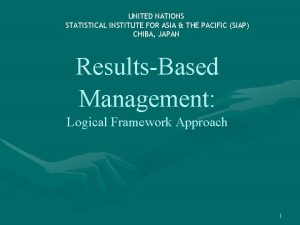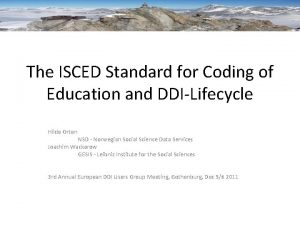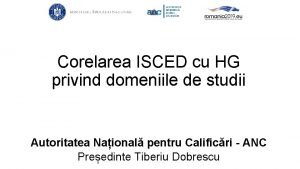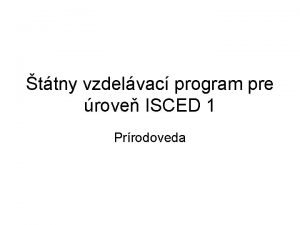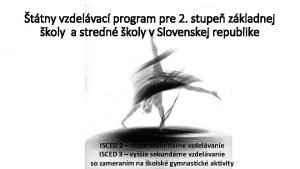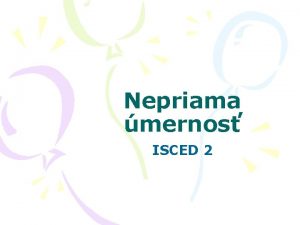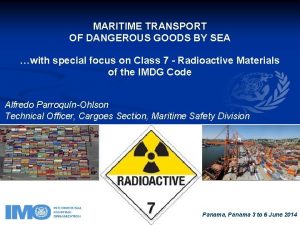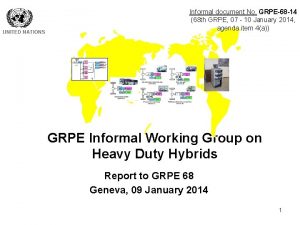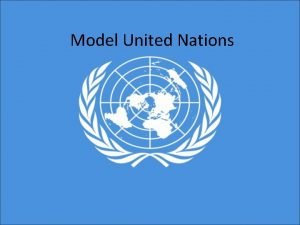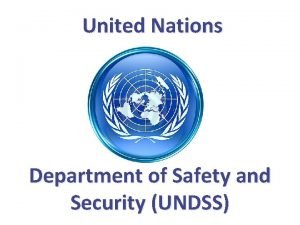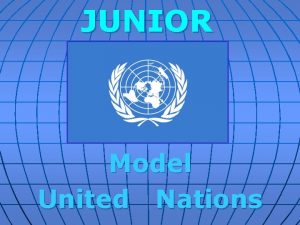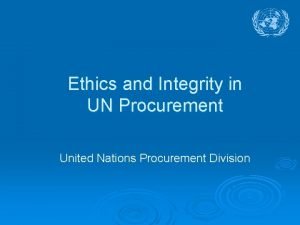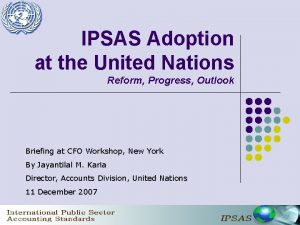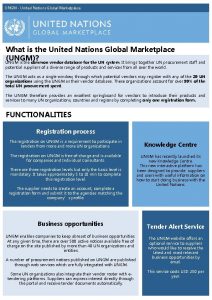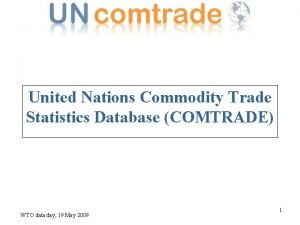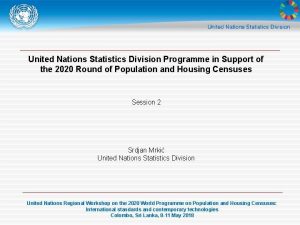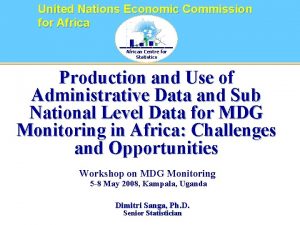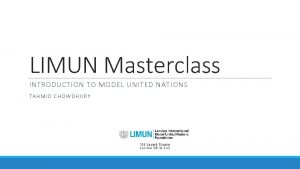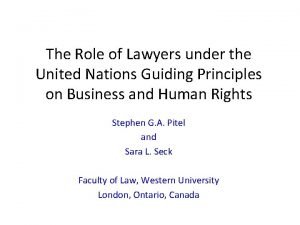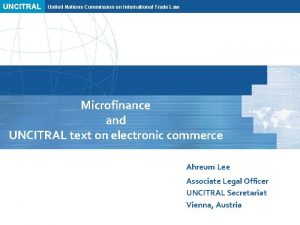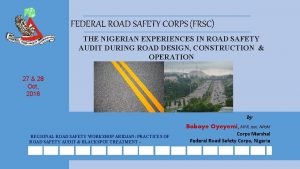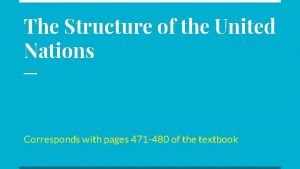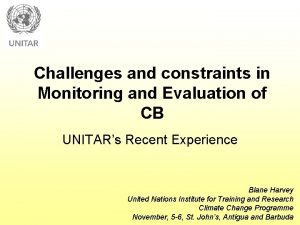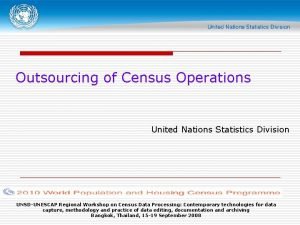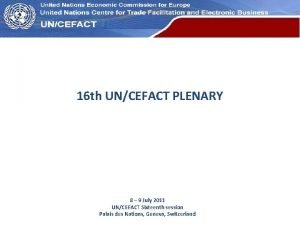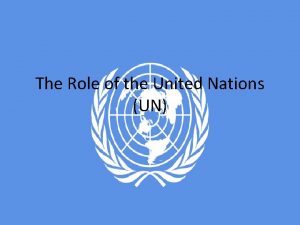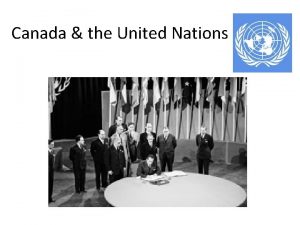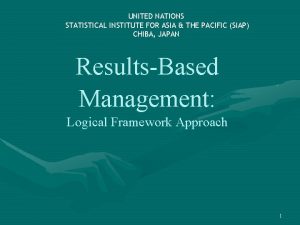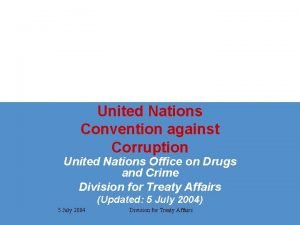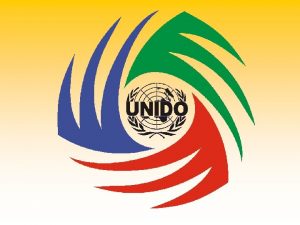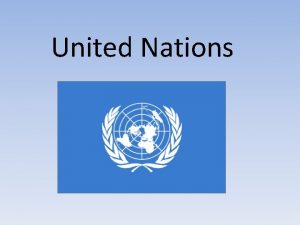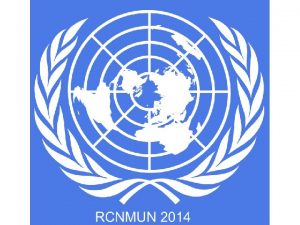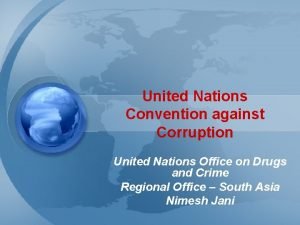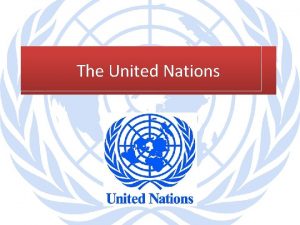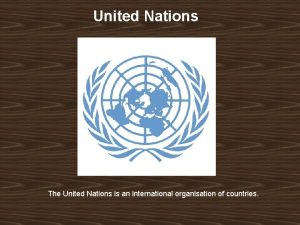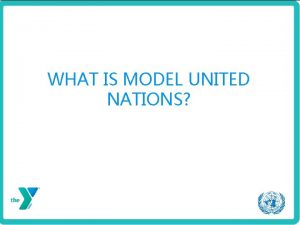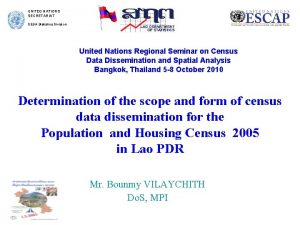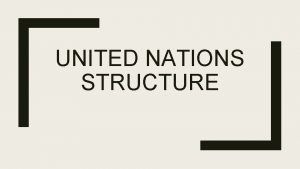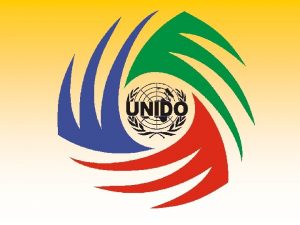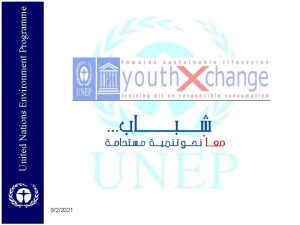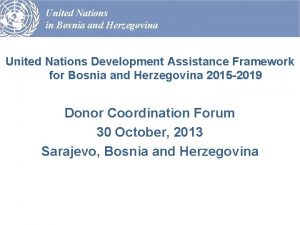ISCED 97 United Nations Statistical Institute For Asia
















































- Slides: 48

ISCED 97 United Nations Statistical Institute For Asia and the Pacific Second Group Training Course in Module on Fundamental Official Statistics 13 – 14 February 2007 Chiba, JAPAN UNESCO INSTITUTE for STATISTICS

ISCED 97 is. . . l The International Standard Classification of EDucation (published in November 1997) l A framework for compiling or reporting cross-nationally comparable statistics on education UNESCO INSTITUTE for STATISTICS

ISCED 97 - Past, Present & Future. . .

Use of ISCED 97

Why is ISCED 97 useful? l It standardises statistics in order to yield data for quality regional & international comparisons l Policy relevance, well-informed and evidencebased decision-making Facilitates exchange of information and knowledge l

Why is ISCED 97 useful? ISCED 97 permits: l Better informed international comparison data on education è è National and international policy formulation Monitoring the international goals (EFA, MDG) International standard setting Comparative analysis

ISCED 97 is not. . . l l A model for the ideal education system An ideal model for reporting national statistics on education (although it can be used for this) A means of measuring the quality of an education programme The definition of the coverage of the UIS or other education surveys UNESCO INSTITUTE for STATISTICS

What is education? l In ISCED terms it is « ORGANIZED and SUSTAINED COMMUNICATION designed to bring about LEARNING. » UNESCO INSTITUTE for STATISTICS

Organized l In ISCED terms implies « PLANNED …. with explicit … aims » (i. e. it is deliberate and intentional) UNESCO INSTITUTE for STATISTICS

Sustained l In ISCED terms implies « duration and continuity » Thus very short or « one-off » learning experiences are not covered UNESCO INSTITUTE for STATISTICS

Communication l In ISCED terms implies « a relationship between TWO OR MORE PEOPLE involving the transfer of information » UNESCO INSTITUTE for STATISTICS

Learning l In ISCED terms is « any improvement in behavior, information, knowledge, understanding, attitude, value or skills » UNESCO INSTITUTE for STATISTICS

How is ISCED 97 constructed? ISCED 97 classifies national PROGRAMMES of education by: FIELDS of study and LEVELS of education UNESCO INSTITUTE for STATISTICS

How is ISCED 97 constructed? l The 9 BROAD FIELDS of study are: è 0 = General programmes è 1 = Education è 2 = Humanities and arts è 3 = Social sciences, business and law è 4 = Science è 5 = Engineering, manufacturing and construction è 6 = Agriculture è 7 = Health & Welfare è 8 = Services

How is ISCED 97 constructed? l The 7 LEVELS of education are: è ISCED 0 = Pre-primary è ISCED 1 = Primary è ISCED 2 = Lower secondary è ISCED 3 = Upper secondary è ISCED 4 = Post-secondary non-tertiary è ISCED 5 = First stage of tertiary education (not leading directly to an advanced research qualification) è ISCED 6 = Second stage of tertiary education (leading to an advanced research qualification) UNESCO INSTITUTE for STATISTICS

How is ISCED 97 constructed? l Within the LEVELS, programmes are also designated by other variables, for example: è PROGRAMME DESTINATION (A, B or C) and è PROGRAMME ORIENTATION

How is ISCED 97 constructed? l PROGRAMME DESTINATION describes the type of educational or labour-market pathway to which a given programme is intended to lead

How is ISCED 97 constructed? l ISCED 97 attempts to classify the curriculum content of education programmes l Usually by using proxy criteria è eg entrance age, duration, qualifications awarded, intended destination UNESCO INSTITUTE for STATISTICS

How is ISCED 97 constructed? l The 7 LEVELS of education are: è ISCED 0 = Pre-primary è ISCED 1 = Primary è ISCED 2 = Lower secondary è ISCED 3 = Upper secondary è ISCED 4 = Post-secondary non-tertiary è ISCED 5 = First stage of tertiary education (not leading directly to an advanced research qualification) è ISCED 6 = Second stage of tertiary education (leading to an advanced research qualification) UNESCO INSTITUTE for STATISTICS

Key features of ISCED 0 l Designed primarily to introduce very young children to a school-type enviroment è è It is school- or centre-based Programmes are designed for children aged 3 and over It ends at the normal age for entry to primary Staff may have teaching qualifications UNESCO INSTITUTE for STATISTICS

Key features of ISCED 1 l Normally designed on a unit or project basis to give students a sound basic education in reading, writing and maths è è Begins usually between ages 5 and 7 Lasts typically 6 years BUT where basic education exists and it is in two parts, the first part is ISCED 1 Marks the start of systematic studies in reading, writing and maths Begins often at the start of compulsory education UNESCO INSTITUTE for STATISTICS

Key features of ISCED 2 l Designed to complete the provision of basic education … and to lay the foundation for lifelong learning. è è è Usually more subject-oriented teaching Taught by better qualified or specialised teachers Begins after approx 6 years of ISCED 1 Ends after approx 9 years of education since the start of ISCED 1 End may coincide with the end of compulsory education UNESCO INSTITUTE for STATISTICS

Key features of ISCED 3 l Involves more specialisation than at ISCED 2 (both on the part of the student and of the teacher) è è è Entrance requirements are typically successful completion of ISCED 2 Usually begins approx 9 years after the start of ISCED 1 Typical entrance ages are 15 or 16 UNESCO INSTITUTE for STATISTICS

Key features of ISCED 4 l Programmes that straddle the boundary between upper-secondary and post-secondary education è è è Curricula are often not significantly more advanced than programmes at ISCED 3 Students are typically older than ISCED 3 students Duration is typically 6 months to 2 years Entrance requirements are usually completion of ISCED 3 Typical programmes are: preparation for university entrance; second programmes; short vocational programmes UNESCO INSTITUTE for STATISTICS

Key features of ISCED 5 l Programmes are clearly more advanced than ISCED 3 programmes è è è Entry requirements are successful completion of ISCED 3 A or 3 B or 4 A programmes (but NOT ISCED 3 C only) Duration is at least 2 years for first programmes at this level Covers all tertiary education except the most advanced research degrees (such as Doctorates, Ph. Ds etc) UNESCO INSTITUTE for STATISTICS

Key features of ISCED 6 l Programmes which lead to the award of an advanced research degree or qualification è è Requires the submission of a thesis or dissertation of PUBLISHABLE quality which is the product of ORIGINAL RESEARCH and represents a SIGNIFICANT contribution to knowledge Prepares graduates for faculty posts in institutions offering ISCED 5 A programmes UNESCO INSTITUTE for STATISTICS

Programme destination l The type of further education (or programmes) to which a given programme is DESIGNED to lead. UNESCO INSTITUTE for STATISTICS

Programme destination There also 3 types of DESTINATION. They are designated by the letters: è A - lead to programmes at the next higher level and are on a direct pathway to level 6 è B - lead to programmes at the next higher level, but are not on a direct pathway to level 6 è C - do not lead to programmes at the next higher level UNESCO INSTITUTE for STATISTICS

Key features of ISCED 2 A, B and C l ISCED 2 A = programmes on a direct pathway to ISCED 6 (ie education designed for typical children or young people) l ISCED 2 B = programmes designed to lead to ISCED 3 C (occur very rarely) l ISCED 2 C = programmes designed to lead to the labour market (typically pre-vocational programmes designed for less able students to give some orientation towards the world of work) UNESCO INSTITUTE for STATISTICS

Key features of ISCED 3 A, B and C l ISCED 3 A = programmes designed to lead to ISCED 5 A programmes (often first university degree programmes) l ISCED 3 B = programmes designed to lead to ISCED 5 B programmes l ISCED 3 C = all other upper secondary programmes. These programmes do not give direct access to ISCED 5. UNESCO INSTITUTE for STATISTICS

Key features of ISCED 4 A and B l ISCED 4 A = programmes designed to lead to ISCED 5 (either 5 A or 5 B) l ISCED 4 B = programmes designed to lead to the labour market (typically more vocational programmes) UNESCO INSTITUTE for STATISTICS

Key features of ISCED 5 A l l Programmes which are on a direct pathway to ISCED 6 Largely theoretically based First programmes have a minimum duration of 3 years First programmes are typically first university degrees (regardless of subject matter) UNESCO INSTITUTE for STATISTICS

Key features of ISCED 5 A l Second progammes are any programmes (regardless of subject or duration – except VERY short) which require successful completion of an ISCED 5 A first programme è are not at the advanced research degree level è UNESCO INSTITUTE for STATISTICS

Key features of ISCED 5 B l l l Programme content is clearly more advanced than ISCED 3 programmes But not on a direct pathway to ISCED 6 Duration is typically shorter than ISCED 5 A Focus more on occupationally-specific skills and less on theoretical content Designed to lead to the labour market UNESCO INSTITUTE for STATISTICS

Additional dimensions l Within the LEVELS, programmes are also designated by other variables: è ORIENTATION (general/vocational) and è DESTINATION (A, B or C) UNESCO INSTITUTE for STATISTICS

Programme orientation l The degree to which a programme is specifically oriented towards a predetermined class (or groups) of occupations or trades. UNESCO INSTITUTE for STATISTICS

Programme orientation l There are 3 possible types of ORIENTATION for programme content. These are: General è Pre-Technical/Pre-Vocational è Technical/Vocational è UNESCO INSTITUTE for STATISTICS

Correspondence between 1976 and 1997 ISCED 76 ISCED 97 0 Education preceding the first level 0 Pre-primary education 1 Education at the first level 1 Primary education or first stage of basic education 2 Education at the second level, first stage 2 Lower secondary or second stage of basic education (2 A, 2 B and 2 C) 3 Education at the second level, second stage 3 Upper secondary education (3 A, 3 B, 3 C) 4 Post secondary Non-tertiary education (4 A, 4 B) 5 First stage of tertiary education (not leading directly to an advanced research qualification (5 A, 5 B) 6 Second stage of tertiary education (leading to an advanced qualification) 5 Education at the third level, first stage, of the type that leads to an award not equivalent to a First degree university 6 Education at the third level, first stage, of the type that leads to a first university degree or equivalent 7 Education at the third level, second stage of the type that leads to a post-graduate university degree or equivalent 9 Education not definable by level UNESCO INSTITUTE for STATISTICS research

ISCED by Level ISCED 97 Level 0 Level 1 Level 2 A B C Level 3 A B C Level 4 A B Level 5 A B Level 6 UNESCO INSTITUTE for STATISTICS Labour Market

An ISCED 97 mapping is. . . …A visual presentation of the national education structure, with a breakdown by: l ISCED 97 LEVEL è ORIENTATION è DESTINATION

Mapping programmes into ISCED • • • What is the starting age? What is the typical duration? Minimum? What are the qualifications awarded? What are the aims? What are the entrance requirements? What does the programme lead to (destination)? What is the orientation? Is it school- or centre-based? What qualifications do teachers have?

The application of ISCED 97 In theory… è Make a thorough list of all national programmes and their characteristics è Use the proxies of programme content to establish the levels è Examine the main and subsidiary criteria at each level è Determine the orientation & destination

Education and learning RANDOM LEARNING INFORMAL LEARNING FORMAL EDUCATION NON-FORMAL EDUCATION (Intentional self-directed, family-directed and socially-directed learning) (Unintentional learning in daily life and through the media and communications)

Defining the type of education 1. 2. 3. 4. 5. 6. 7. 8. 9. 10. Intentionality Organization Institutional framework and location Target population Flexibility of teaching/learning methods Full-time or part-time studies Scheduled duration Registration Admission requirements Hierarchical level-grade structure

Formal vs. Non-Formal • Random learning: need not match any of the criteria given below. • Informal learning: needs to match only criteria 1. • Non-Formal Education: needs to match at least criteria 1 to 7. • Formal Education: needs to match all 10 criteria. UNESCO INSTITUTE for STATISTICS

Nature of NFE • • • Organized programmes at various levels Diversity/Flexibility in programme approaches Regular/ad hoc in frequency Various actors and target groups Concepts, definition and understanding vary among actors Monitoring mechanism not properly coordinated

NFE Monitoring Scope All intentional and organized learning activities (with clearly defined location, target population, teaching-learning contents and methods, schedule and duration) that take place beyond the regular formal educational programmes in schools, universities and other educational institutions.

Exercises l l Please map your country’s education system into ISCED 97 Think of how you have been educated and map your education history into ISCED 97 UNESCO INSTITUTE for STATISTICS
 Statistical institute for asia and the pacific
Statistical institute for asia and the pacific Isced 2011
Isced 2011 Clasificare studii superioare isced
Clasificare studii superioare isced Ttny
Ttny Isced (international standard classification of education)
Isced (international standard classification of education) štátny vzdelávací program isced 0
štátny vzdelávací program isced 0 Isced tabulka
Isced tabulka Class 7 dangerous goods
Class 7 dangerous goods United nations
United nations Model united nations
Model united nations Undss
Undss United nations flag
United nations flag Anatolia college mun
Anatolia college mun United nations flag
United nations flag United nations zambia
United nations zambia Ethics and integrity at the united nations
Ethics and integrity at the united nations Ipsas united nations
Ipsas united nations Introduction of un
Introduction of un The agency sponsored by the united nations that compiles
The agency sponsored by the united nations that compiles What is ungm
What is ungm United nations commodity trade statistics database
United nations commodity trade statistics database United nations statistics division
United nations statistics division United nations
United nations Introduction to model united nations
Introduction to model united nations Opsp united nations
Opsp united nations United nations basic principles on the role of lawyers
United nations basic principles on the role of lawyers United nations
United nations Vision and mission of frsc
Vision and mission of frsc Six main organs of the united nations
Six main organs of the united nations Unicef is mandated by the
Unicef is mandated by the Patricia nemeth united nations
Patricia nemeth united nations United nations
United nations Constraints in monitoring and evaluation
Constraints in monitoring and evaluation United nations
United nations United nations statistics division
United nations statistics division United nations economic commission for europe
United nations economic commission for europe Christian saunders united nations
Christian saunders united nations What is the role of the united nations?
What is the role of the united nations? Personlig tidbok för yrkesförare
Personlig tidbok för yrkesförare Handledning reflektionsmodellen
Handledning reflektionsmodellen Varför kallas perioden 1918-1939 för mellankrigstiden
Varför kallas perioden 1918-1939 för mellankrigstiden Borstål, egenskaper
Borstål, egenskaper Vilken grundregel finns det för tronföljden i sverige?
Vilken grundregel finns det för tronföljden i sverige? Verktyg för automatisering av utbetalningar
Verktyg för automatisering av utbetalningar Vishnuiter
Vishnuiter Jätte råtta
Jätte råtta Kolopskopi
Kolopskopi Lyckans minut erik lindorm analys
Lyckans minut erik lindorm analys Strategi för svensk viltförvaltning
Strategi för svensk viltförvaltning
